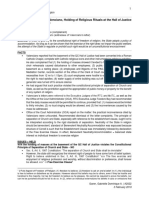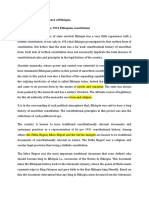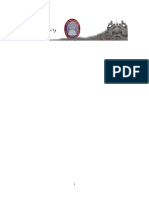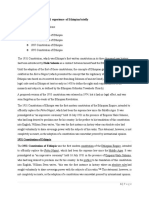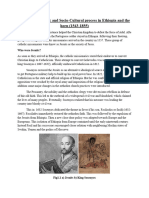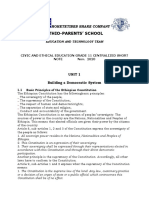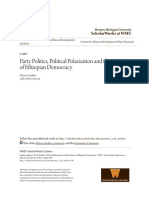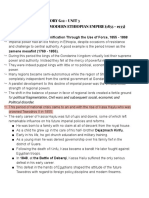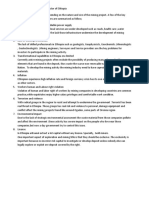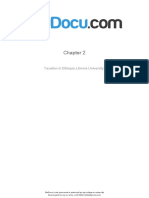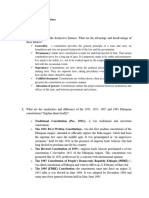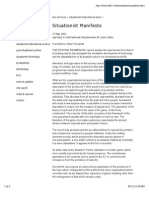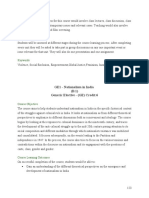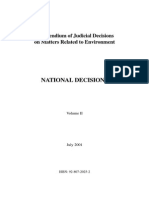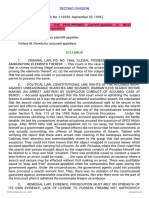100%(1)100% found this document useful (1 vote)
476 viewsThe History of Constitution in Ethiopia
The History of Constitution in Ethiopia
Uploaded by
yordanos mulukenThe history of constitutions in Ethiopia began in 1931 with the introduction of a parliamentary system, though the monarch still held absolute power. Prior to 1974, Ethiopia was ruled under the divine right of kings based on legends that monarchs were descended from King Solomon. The 1995 constitution established a federal democratic republic and outlined citizens' rights and the division of powers between federal and regional states, serving as the supreme law.
Copyright:
© All Rights Reserved
Available Formats
Download as DOCX, PDF, TXT or read online from Scribd
The History of Constitution in Ethiopia
The History of Constitution in Ethiopia
Uploaded by
yordanos muluken100%(1)100% found this document useful (1 vote)
476 views3 pagesThe history of constitutions in Ethiopia began in 1931 with the introduction of a parliamentary system, though the monarch still held absolute power. Prior to 1974, Ethiopia was ruled under the divine right of kings based on legends that monarchs were descended from King Solomon. The 1995 constitution established a federal democratic republic and outlined citizens' rights and the division of powers between federal and regional states, serving as the supreme law.
Original Description:
This is about the history of constitution in ethiopia
Original Title
The history of constitution in Ethiopia
Copyright
© © All Rights Reserved
Available Formats
DOCX, PDF, TXT or read online from Scribd
Share this document
Did you find this document useful?
Is this content inappropriate?
The history of constitutions in Ethiopia began in 1931 with the introduction of a parliamentary system, though the monarch still held absolute power. Prior to 1974, Ethiopia was ruled under the divine right of kings based on legends that monarchs were descended from King Solomon. The 1995 constitution established a federal democratic republic and outlined citizens' rights and the division of powers between federal and regional states, serving as the supreme law.
Copyright:
© All Rights Reserved
Available Formats
Download as DOCX, PDF, TXT or read online from Scribd
Download as docx, pdf, or txt
100%(1)100% found this document useful (1 vote)
476 views3 pagesThe History of Constitution in Ethiopia
The History of Constitution in Ethiopia
Uploaded by
yordanos mulukenThe history of constitutions in Ethiopia began in 1931 with the introduction of a parliamentary system, though the monarch still held absolute power. Prior to 1974, Ethiopia was ruled under the divine right of kings based on legends that monarchs were descended from King Solomon. The 1995 constitution established a federal democratic republic and outlined citizens' rights and the division of powers between federal and regional states, serving as the supreme law.
Copyright:
© All Rights Reserved
Available Formats
Download as DOCX, PDF, TXT or read online from Scribd
Download as docx, pdf, or txt
You are on page 1of 3
The history of constitution in Ethiopia
The formation of the modern Ethiopian state was completed by the end
of the 19th century. Before 1974, the political system in Ethiopia was set
up on the bass of the divine right of kings. Monarchs claimed to be
elected by God.
The divine power of Ethiopian monarchs is stated by in such document
like Kibere Negest/ glory of kings/ and Fetha Negest/ Law of kings/.
Kibere Negest is written legend about the Jewish origin of the Ethiopian
monarchs. According to this legend, a queen of Ethiopia by the ame of
Sheba paid a visit to the king of Israel, Solomon, for whom she bore a
child. The son of Solomon, named Menelik l, became the king of
Ethiopia and hence the founder of the so called Solomonic Dynasty. The
Christian rulers of Ethiopia wanted to persuade the people about their
divine power by associating themselves to Israel. Fetha Negest thus
states “the king is the minister of God”. It further relates that opposing
the king is sin.
1931 Constitution
The 1931 constitution of Ethiopia has brought some change by
introducing a parliamentary system. However it gave absolute power to
the monarch who, among other things had a right to
Appoint members of the legislative body\
Appoint or dismiss high- ranking civil and military officials
including ministers
Declare and end war
Though some rights of citizens like freedom of movements and
security of life and property exist in this constitution other
more fundamental rights human and political rights of people
are denied.
1995 Constitution
The 1931 constitution of Ethiopia was revised in 1955 with little
improvement. Some of these improvements available in the
revised constitution of 1955 include such rights like freedom of
speech, freedom of press, and people’s participation of
election of member of chambers of Senate.
1987 Constitution
The draft Constitution of the Derg was presented to the people
for ratification in 1987. However this constitution allowed only
one-party rule and quite naturally did not lead to a political
transformation towards a truly democratic system. The
president of Derg remained the absolute source of and mover
of all powers of the one-party he represented.
The 1955 Constitution
The constitution of the Federal Democratic Republic of
Ethiopia:
Establish the Federal and Democratic state structure
Outlines the economic, social political and cultural
rights of citizens
States the powers and functions of the federal and
regional states
Outlines the principles of external relations
States the sovereign authority of the states and its
function
Limits the power of government
Serves as the supreme law of motion
You might also like
- Merid Wolde AregayDocument636 pagesMerid Wolde AregayBelaynew92% (12)
- Wimpy Kid Book 1 Questions PDFDocument4 pagesWimpy Kid Book 1 Questions PDFIsabel Tobar100% (3)
- Wolqait TegedeDocument51 pagesWolqait TegedeThe Ethiopian Affair100% (5)
- Ethiopian Civil Code 1960 PDFDocument2 pagesEthiopian Civil Code 1960 PDFRachel67% (3)
- Ethiopian Book PDFDocument2 pagesEthiopian Book PDFKrista61% (18)
- Re Letter of Tony Q Valenciano (Digest)Document3 pagesRe Letter of Tony Q Valenciano (Digest)Quake G.91% (11)
- Constitutional Experience of EthiopiaDocument13 pagesConstitutional Experience of EthiopiaIrsan-Demha Idba Orbi100% (2)
- The Ethiopian Constitution - Docx MMMMMDocument30 pagesThe Ethiopian Constitution - Docx MMMMMMELAKU100% (1)
- Constitutional Development in Ethiopia-Civic AssignmentDocument9 pagesConstitutional Development in Ethiopia-Civic AssignmentAbenezer Yohannes100% (2)
- Discuss The Constitutional Experience of Ethiopian BrieflyDocument6 pagesDiscuss The Constitutional Experience of Ethiopian BrieflyAbdela Aman Mtech100% (4)
- FDRE ConstitutionDocument10 pagesFDRE ConstitutionHailegebreal Bekele100% (2)
- The Revised Constitution of 1955Document8 pagesThe Revised Constitution of 1955Biniyam DugumaNo ratings yet
- 1931 Constitution of EthiopiaDocument12 pages1931 Constitution of EthiopiaBiniyam Duguma100% (7)
- Ethiopian Constitution 1931 PDFDocument2 pagesEthiopian Constitution 1931 PDFLori100% (3)
- Emergence of Autocracy in Ethiopia PDFDocument4 pagesEmergence of Autocracy in Ethiopia PDFrekikNo ratings yet
- Civics Course Power Point Chapter 4Document61 pagesCivics Course Power Point Chapter 4abenezer100% (3)
- Ethiopian Constitution PDF Amharic VersionDocument2 pagesEthiopian Constitution PDF Amharic VersionShadrick85% (13)
- Overview On The Ethiopian ConstitutionDocument6 pagesOverview On The Ethiopian ConstitutionAmar Elias100% (1)
- Ethiopian Constitution 1987 PDFDocument2 pagesEthiopian Constitution 1987 PDFElizabeth100% (2)
- Zemene Mesafint - Era of PrincesDocument10 pagesZemene Mesafint - Era of PrincesAbenezer KassahunNo ratings yet
- Documenting The Ethiopian Student MovementDocument164 pagesDocumenting The Ethiopian Student MovementMiliyon100% (1)
- Gonder Period and Zemne MesafintDocument10 pagesGonder Period and Zemne MesafintYoftahe AlemuNo ratings yet
- History of Taxation in EthiopiaDocument19 pagesHistory of Taxation in Ethiopiaendeshaw yibetal100% (2)
- Ethiopian Constitution PDF AmharicDocument2 pagesEthiopian Constitution PDF AmharicAlex100% (2)
- Greater Ethiopia The Evolution PDFDocument18 pagesGreater Ethiopia The Evolution PDFEskender EshetuNo ratings yet
- Civics Unit 1 Short Note For G11 Nov 2020Document6 pagesCivics Unit 1 Short Note For G11 Nov 2020Baki100% (4)
- The Amhara People of EthiopiaDocument6 pagesThe Amhara People of Ethiopiaandres0126No ratings yet
- Party Politics, Political Polarization and The Future of Ethiopian DemocracyDocument25 pagesParty Politics, Political Polarization and The Future of Ethiopian DemocracyEfrem WondaleNo ratings yet
- Chapter Three & FourDocument34 pagesChapter Three & FourAsfawosen DingamaNo ratings yet
- South West Ethiopia Regional ConstitutionDocument109 pagesSouth West Ethiopia Regional Constitutionጠበቃ ተግባሩ ተረፈ80% (5)
- Ethiopian Constitution Amharic Version PDFDocument2 pagesEthiopian Constitution Amharic Version PDFMaria88% (8)
- The 1991 Transitional Charter of Ethiopia: A New Application of The Self-Determination PrincipleDocument29 pagesThe 1991 Transitional Charter of Ethiopia: A New Application of The Self-Determination PrincipleWaqoNo ratings yet
- A, Traditional Tax System Prior To 1941-In The Axumite Kingdom, There Was A Practice of TraditionalDocument7 pagesA, Traditional Tax System Prior To 1941-In The Axumite Kingdom, There Was A Practice of Traditionalliya100% (2)
- History G12 - Unit 3Document15 pagesHistory G12 - Unit 3fatra s.No ratings yet
- Civic and Ethical Education Lesson Note For Grade 11.doxDocument3 pagesCivic and Ethical Education Lesson Note For Grade 11.doxMilkias Berhanu100% (19)
- Ethiopian Civil Code PDFDocument2 pagesEthiopian Civil Code PDFGabriel88% (8)
- The Law of Corporate Taxation in EthiopiaDocument73 pagesThe Law of Corporate Taxation in EthiopiayididiyayibNo ratings yet
- Introductory To Ethiopian HistoryDocument108 pagesIntroductory To Ethiopian HistoryHaileluel Wondimneh100% (1)
- Emergence of Modern EthiopiaDocument17 pagesEmergence of Modern EthiopiaZelalemNo ratings yet
- Amhara People Mistaken Identity 200Document46 pagesAmhara People Mistaken Identity 200TWWNo ratings yet
- Brief History of ETHIOPIADocument34 pagesBrief History of ETHIOPIAfriti75% (4)
- Chapter 1Document37 pagesChapter 1Tariku KussiaNo ratings yet
- The Major Challenges of The Mining Sector of EthiopiaDocument1 pageThe Major Challenges of The Mining Sector of Ethiopiaermias gezahegn100% (2)
- Ethio Exit For Law StudentsDocument22 pagesEthio Exit For Law StudentsNahom WerkayehuNo ratings yet
- Unit One: Building A Democratic System Lesson One: Basic Principles of The Ethiopian ConstitutionDocument3 pagesUnit One: Building A Democratic System Lesson One: Basic Principles of The Ethiopian Constitutionbruck simenehNo ratings yet
- Grade 11 Civics WEEK 1Document16 pagesGrade 11 Civics WEEK 1BakiNo ratings yet
- The Foreign Policy of Emperor Menelik II PDFDocument662 pagesThe Foreign Policy of Emperor Menelik II PDFAchamyeleh Tamiru88% (16)
- A History of Nationalism in Ethiopia 1941 2012 PDFDocument389 pagesA History of Nationalism in Ethiopia 1941 2012 PDFs100% (18)
- Unit 2 Taxation in EthiopiaDocument21 pagesUnit 2 Taxation in EthiopiachuchuNo ratings yet
- History of Ethiopia and The Horn AssignmentDocument7 pagesHistory of Ethiopia and The Horn Assignmentlamesawako65No ratings yet
- Tekeste - Ethio-Eritrea Federation PDFDocument235 pagesTekeste - Ethio-Eritrea Federation PDFKibrom Sabian100% (1)
- Compare and Contrast The Ethiopian Previous Investment Law and Current LawDocument10 pagesCompare and Contrast The Ethiopian Previous Investment Law and Current LawBelay Mekuanint100% (1)
- Assignment On Moral and Citizenship EducationDocument1 pageAssignment On Moral and Citizenship Educationkirubel demelash57% (7)
- History of Ethiopian TaxationDocument4 pagesHistory of Ethiopian Taxationsara woldeyohannes100% (3)
- Asafa Jalata - The Oromo Movement and Imperial Politics - Culture and Ideology in Oromia and Ethiopia-Lexington Books (2020)Document210 pagesAsafa Jalata - The Oromo Movement and Imperial Politics - Culture and Ideology in Oromia and Ethiopia-Lexington Books (2020)Mohammed Demssie Mohammed100% (1)
- List of Ethiopian Kings by H.I.MDocument15 pagesList of Ethiopian Kings by H.I.MRalph HartnickNo ratings yet
- Civic and Ethical Education Worksheet One For Grade 11.doxDocument1 pageCivic and Ethical Education Worksheet One For Grade 11.doxAmanuel Tesfaye100% (5)
- Civics Module 2009-1 Admas UniversityDocument95 pagesCivics Module 2009-1 Admas UniversityBetsegaw Demeke0% (1)
- Grade 11 Civics Short Notes: SavingDocument7 pagesGrade 11 Civics Short Notes: SavingPatrix Parker100% (4)
- Sidama PeoplesDocument11 pagesSidama Peopleskangmo Abel100% (1)
- Body, Conclusion & Reference.Document7 pagesBody, Conclusion & Reference.Melakebirhan EndayeNo ratings yet
- Civic Ass 4Document3 pagesCivic Ass 4ErmiasNo ratings yet
- Tieng Anh 8 Friends Plus - Unit 8 - Test 1Document4 pagesTieng Anh 8 Friends Plus - Unit 8 - Test 1Trúc Trương Thị ÁnhNo ratings yet
- 03 Civil Law Syllabus 2018Document7 pages03 Civil Law Syllabus 2018Trisha Kong DeiparineNo ratings yet
- JEST Overall 2023 Deprived TalukasDocument620 pagesJEST Overall 2023 Deprived Talukasaveekhan502No ratings yet
- Situationist ManifestoDocument3 pagesSituationist ManifestoRobert E. HowardNo ratings yet
- Augpaypal 1Document1 pageAugpaypal 1Jamie HullNo ratings yet
- God's Way of Changing The World: Disciple-MakingDocument57 pagesGod's Way of Changing The World: Disciple-Making50ramblingsNo ratings yet
- Hitler DancesDocument3 pagesHitler DancesmixiepixieowlNo ratings yet
- Clemency Petition For Jeff Wood To Texas Governor and Board of Pardons and ParolesDocument22 pagesClemency Petition For Jeff Wood To Texas Governor and Board of Pardons and ParolesScott Cobb100% (4)
- Colores Amarillo-Dulce Verde-Alejandra Gris-Karla Café-Edwin Rosa-DenisseDocument2 pagesColores Amarillo-Dulce Verde-Alejandra Gris-Karla Café-Edwin Rosa-DenisseKarla Oliver MaldonadoNo ratings yet
- The Cold War The Cold War The Cold War The Cold WarDocument18 pagesThe Cold War The Cold War The Cold War The Cold WarAnkur BhattNo ratings yet
- Discuss The Nature and Extent of Slavery As An Institution in Greco-Roman SocietyDocument4 pagesDiscuss The Nature and Extent of Slavery As An Institution in Greco-Roman SocietySouravNo ratings yet
- The Hon'ble Supreme Court of Indica: BeforeDocument39 pagesThe Hon'ble Supreme Court of Indica: BeforeSwastik Grover50% (2)
- Nationalism in India Syllabus.Document4 pagesNationalism in India Syllabus.Sakshi SinghNo ratings yet
- Jutland,: Aval Should - PL yDocument12 pagesJutland,: Aval Should - PL yMark BallingerNo ratings yet
- Pastoral Care PaperDocument10 pagesPastoral Care Paperapi-315229431100% (2)
- Letter To WomenDocument10 pagesLetter To WomenKarla TaylorNo ratings yet
- Anil Dalpat - WikipediaDocument7 pagesAnil Dalpat - WikipediaYuvaraj BhaduryNo ratings yet
- Possession Case DigestsDocument15 pagesPossession Case DigestsMaria Reylan GarciaNo ratings yet
- Judicial Decisions On Matters Related To Environment National DecisionsDocument351 pagesJudicial Decisions On Matters Related To Environment National DecisionsRuben CardozaNo ratings yet
- United States v. Kenneth Warrix, 898 F.2d 149, 4th Cir. (1990)Document2 pagesUnited States v. Kenneth Warrix, 898 F.2d 149, 4th Cir. (1990)Scribd Government DocsNo ratings yet
- Sentencing Memo - Frankie BeqirajDocument10 pagesSentencing Memo - Frankie BeqirajJake ShoreNo ratings yet
- Miners Assoc Vs FactoranDocument2 pagesMiners Assoc Vs FactoranAnonymous NqaBAyNo ratings yet
- Phi Theta Kappa (Alpha Delta Mu) Meeting MinutesDocument4 pagesPhi Theta Kappa (Alpha Delta Mu) Meeting MinutesalphadeltamuNo ratings yet
- List of PartnersDocument16 pagesList of PartnersRizaNo ratings yet
- Decorations of Azad HindDocument2 pagesDecorations of Azad HindJean-pierre NegreNo ratings yet
- Conditional Sentences BasicDocument2 pagesConditional Sentences BasicPhan Nguyễn Hồng Ngọc -MĐC- 12A22No ratings yet
- BALLB 2020 Indian History 1 Session 2Document13 pagesBALLB 2020 Indian History 1 Session 2Daksh MengiNo ratings yet
- Plaintiff-Appellee Vs Vs Accused-Appellant The Solicitor General Violeta M. PareñaDocument8 pagesPlaintiff-Appellee Vs Vs Accused-Appellant The Solicitor General Violeta M. PareñaDora the ExplorerNo ratings yet





